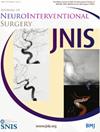椎-基底动脉穿孔器的神经解剖学:对动脉瘤治疗的影响。
IF 4.5
1区 医学
Q1 NEUROIMAGING
引用次数: 0
摘要
椎基底动脉穿孔器的解剖学已在人体尸体上进行了广泛研究,大部分报告见于神经外科文献。传统的二维数字减影血管造影术很难持续观察到这些动脉穿孔,但横断面锥形束 CT 技术却能可靠地观察到。清楚地了解这种特殊的神经血管解剖和病理,对于做出明智的治疗决定至关重要。这篇综述分析了椎基底动脉穿孔器的解剖结构,重点关注对动脉瘤治疗的实际影响,尤其是血流分流。本文章由计算机程序翻译,如有差异,请以英文原文为准。
Neuroanatomy of the vertebrobasilar perforators: implications for aneurysm treatment.
The anatomy of vertebrobasilar perforators has been widely studied in human cadavers, with most reports found in the neurosurgical literature. These arterial perforators are extremely hard to visualize consistently with traditional two-dimensional digital subtraction angiography, but are reliably visible with cross sectional cone beam CT techniques. A clear understanding of this specific neurovascular anatomy and pathology is essential for informed treatment decisions. This review analyzes the anatomy of vertebrobasilar perforators with a focus on practical implications for aneurysm treatment, particularly flow diversion.
求助全文
通过发布文献求助,成功后即可免费获取论文全文。
去求助
来源期刊

Journal of NeuroInterventional Surgery
NEUROIMAGING-SURGERY
CiteScore
9.50
自引率
14.60%
发文量
291
审稿时长
4-8 weeks
期刊介绍:
The Journal of NeuroInterventional Surgery (JNIS) is a leading peer review journal for scientific research and literature pertaining to the field of neurointerventional surgery. The journal launch follows growing professional interest in neurointerventional techniques for the treatment of a range of neurological and vascular problems including stroke, aneurysms, brain tumors, and spinal compression.The journal is owned by SNIS and is also the official journal of the Interventional Chapter of the Australian and New Zealand Society of Neuroradiology (ANZSNR), the Canadian Interventional Neuro Group, the Hong Kong Neurological Society (HKNS) and the Neuroradiological Society of Taiwan.
 求助内容:
求助内容: 应助结果提醒方式:
应助结果提醒方式:


